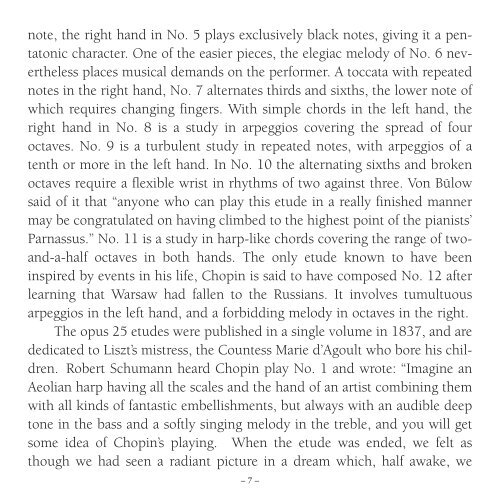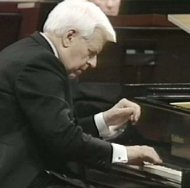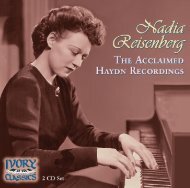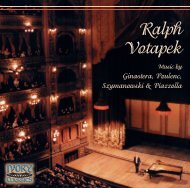IC 76003 Booklet - Ivory Classics
IC 76003 Booklet - Ivory Classics
IC 76003 Booklet - Ivory Classics
You also want an ePaper? Increase the reach of your titles
YUMPU automatically turns print PDFs into web optimized ePapers that Google loves.
note, the right hand in No. 5 plays exclusively black notes, giving it a pentatonic<br />
character. One of the easier pieces, the elegiac melody of No. 6 nevertheless<br />
places musical demands on the performer. A toccata with repeated<br />
notes in the right hand, No. 7 alternates thirds and sixths, the lower note of<br />
which requires changing fingers. With simple chords in the left hand, the<br />
right hand in No. 8 is a study in arpeggios covering the spread of four<br />
octaves. No. 9 is a turbulent study in repeated notes, with arpeggios of a<br />
tenth or more in the left hand. In No. 10 the alternating sixths and broken<br />
octaves require a flexible wrist in rhythms of two against three. Von Bülow<br />
said of it that “anyone who can play this etude in a really finished manner<br />
may be congratulated on having climbed to the highest point of the pianists’<br />
Parnassus.” No. 11 is a study in harp-like chords covering the range of twoand-a-half<br />
octaves in both hands. The only etude known to have been<br />
inspired by events in his life, Chopin is said to have composed No. 12 after<br />
learning that Warsaw had fallen to the Russians. It involves tumultuous<br />
arpeggios in the left hand, and a forbidding melody in octaves in the right.<br />
The opus 25 etudes were published in a single volume in 1837, and are<br />
dedicated to Liszt’s mistress, the Countess Marie d’Agoult who bore his children.<br />
Robert Schumann heard Chopin play No. 1 and wrote: “Imagine an<br />
Aeolian harp having all the scales and the hand of an artist combining them<br />
with all kinds of fantastic embellishments, but always with an audible deep<br />
tone in the bass and a softly singing melody in the treble, and you will get<br />
some idea of Chopin’s playing. When the etude was ended, we felt as<br />
though we had seen a radiant picture in a dream which, half awake, we<br />
– 7 –














